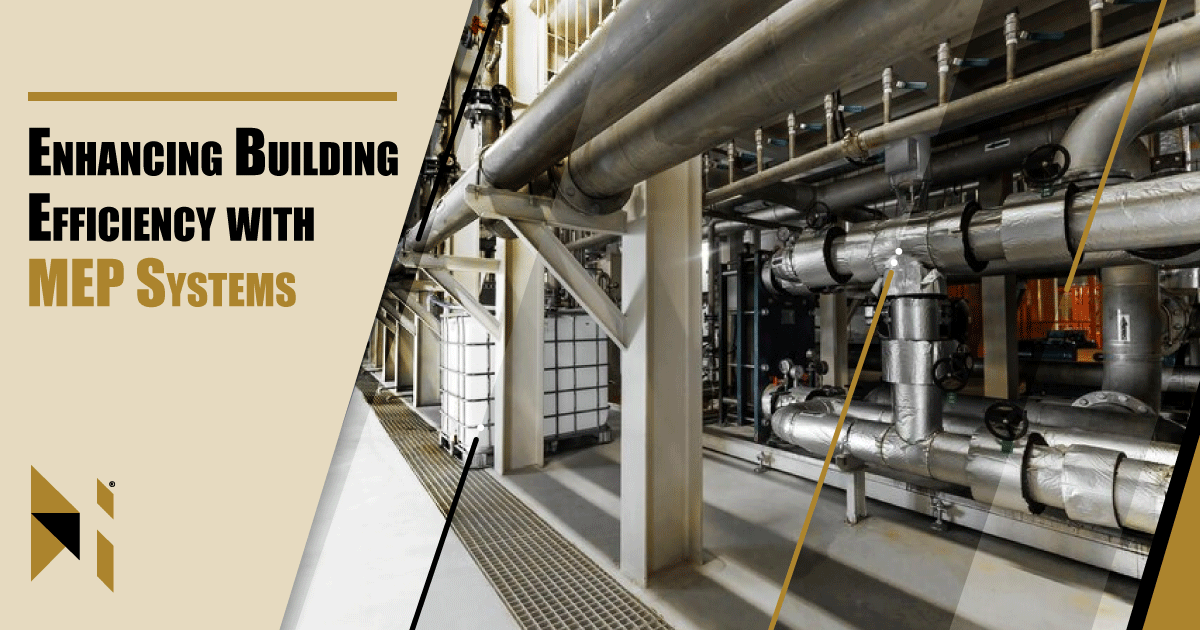MEP is considered the backbone of any construction project that wants to get more from the building. Many projects do not consider MEP as important or necessary to maintain various things associated with a building. They may have a point to a point but involving MEP systems can be beneficial when you need to find what the building is consuming in terms of energy, and electricity, and where the expense goes each month. There are many things that an MEP system helps to calculate and provide in-depth analysis in this regard.
But when it comes to enhancing a system, it is a whole new story. MEP is easy to install and maintain but it is difficult to improve or enhance it. By easy, we do not mean that is a simple walk in the park but with experienced professionals such as Silver Foundation around, the overall task becomes relatively easy. When it is about enhancing the same system, requires skill, mindset, and a keen eye on the present technologies. Enhancing an MEP system is difficult since you need to upgrade a step higher than the current condition for which you need improvements and additions. This is only possible when you implement the ongoing hot trends in the market and adapt your system to them.
MEP stands for Mechanical, Electrical, and Plumbing and is a comprehensive system in any construction project. For any construction project, it is necessary to define the scope of the project and the purpose of the project. Buildings such as homes and outlets may not require MEP as a primary system however projects such as commercial plazas, shopping malls, and offices do need MEP systems. To understand an MEP system, you should consider that such a system forms by merging the sub-systems of mechanical, electrical, and plumbing systems. Hence, you can treat the three services of MEP as three sub-systems that combine to produce a large and single MEP system.
There is no boundary for an MEP system and you can gain as much as you want from a single system. For example, you can ideally design your electrical sub-system to save as much energy as possible in conjunction with a fine HVAC system through a mechanical system. And this is possible when the plumbing is foolproof. It is also necessary to note that the different sub-systems of an MEP system do not work independently but are finely linked to each other. You cannot expect HVAC to provide better or required results if the electrical system is weak or faulty and vice versa. To ensure that your system is ideal and up to the mark, just focus on getting the right MEP system into practice.
Enhancing an MEP System
Now we move to our topic of discussion that how can we improve our existing MEP system. In terms of construction, engineering, and systems, improving refers to enhancing and upgrading. Improvements are always considered when you look to correct a faulty system. So if you do have a good or operable MEP system installed in your building and you want to gain more results and output, you will need to upgrade it. One simple goal must be present in your mind you must focus on enhancing the efficiency of your building through an MEP service and system. And below we enlist those top points that you can follow for the same purpose.
Upgrading HVAC System
HVAC or Heating, Ventilating, and Air-Conditioning is a system that is considered the backbone of the mechanical sub-system and the entire MEP system. Particularly, this is due to the importance and outcome associated with an HVAC system. The HVAC system is responsible for the heating and cooling system of a building through ideal ventilation. This can be the most basic definition of the HVAC system though this does not reflect its principle.
But when you connect the dots, you will find out that for an HVAC to be effective, it must be constantly upgraded using various techniques such as incorporating natural ventilation and heating sources, integrating conventional systems, upgrading to thermal storage and free cooling, and utilization of modern sensors can all help to improve an HVAC system.
Prevent Air Leakage
Windows are not the only you can improve the efficiency of your building and curb air stoppage, you need some proper inspection results that where the air goes out from through the building. Often, upon audit and inspection, it is found that there are gaps and spaces either at the top or bottom of exterior walls, along the doors and windows, and cracks present in these areas.
All these loopholes provide for the air inside the building to seep out and thus require more energy consumption for various reasons such as cooling and heating. If you take a step ahead and find estimations, you will come to know that you require more energy to heat your building in winter and cool up the building during summer. All of this is due to a basic phenomenon of air leakage that needs to be prevented at all costs.
Retro Windows
There are many theories of bringing in new windows to a space to make it look cool, casual, and aesthetic however when it comes to functionality, it is not always a good idea. We’ll get to the ideas later but let us discuss the actual need to install a new window. People add new windows with cleaner shades and a high level of transparency to give a vibrant look.
For example, if your window is extremely transparent, you cannot achieve efficiency since there will be a constant loophole such as increased temperatures for your building. What retro windows do is that they come equipped with older methods and designs such as tinted shades with yellow tints that do not allow sunlight to directly pass through them.
Prevent Air Leakage
Windows are not the only you can improve the efficiency of your building and curb air stoppage, you need some proper inspection results that where the air goes out from through the building. Often, upon audit and inspection, it is found that there are gaps and spaces either at the top or bottom of exterior walls, along the doors and windows, and cracks present in these areas.
All these loopholes provide for the air inside the building to seep out and thus require more energy consumption for various reasons such as cooling and heating. If you take a step ahead and find estimations, you will come to know that you require more energy to heat your building in winter and cool up the building during summer.
Getting the desired or required output from an MEP system is the goal, mission, and requirement of all stakeholders but only a few spend some time and dedication for the outcome. When you consider the first way of improving the efficiency of an MEP system, we singled out conducting energy audits. An audit is the best way to inspect and judge for various factors and not just energy alone. This provides a broader picture that what you must do to provide an efficient structure. Moving further, you can utilize many standard and traditional practices that hamper your energy conservation. Air leakage is considered one of the most common reasons for high energy consumption to compensate for the losses. And if you can plan well to curb it, you can save a considerable amount of energy. Finally, a good and effective HVAC system is the key to an energy-efficient MEP system and you can do it in all the different ways with the help of professional MEP contractors such as Silver Foundation.
Frequently Asked Questions
What are the three MEP sub-systems?
MEP sub-systems include Mechanical, Electrical, and Plumbing.
Why are Mechanical, Electrical, and Plumbing considered as sub-systems?
We consider them sub-systems since mechanical, electrical, and plumbing services involve their distinct features and thus they must be considered individual systems making a larger MEP system.
What does HVAC focus on?
HVAC primarily focuses on the heating and cooling system of a building alongside establishing a good ventilation system. HVAC is considered the backbone of both the mechanical sub-system and the MEP system as a whole.
What type of audit is best for efficiency estimation?
An energy audit is always preferred when it comes to energy estimation in an MEP system.
Who installs an MEP system?
MEP systems are designed, installed, maintained, and upgraded by professional MEP contractors and firms.

